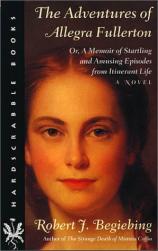Reading Group Guide
Discussion Questions
The Adventures of Allegra Fullerton: Or, A Memoir of Startling and Amusing Episodes from Itinerant Life-A Novel

1. Like Hawthorne's The Scarlet Letter, The Adventures of Allegra Fullerton is presented to the reader as a "found" manuscript. How does this notion, introduced at the outset, affect your reading of the book? Why might the author create this "frame" for the book, rather than diving directly into Allegra's story?
2. The preface refers to the narrative both as a "novel" and a "memoir." Though the overall work is clearly fiction, why might the author introduce such an ambiguity into the frame story? How does this ambiguity affect your reading of the novel?
3. The preface makes reference to "the metallic -- dare I say lifeless? -- brilliancy of so many of our own contemporary authors." What sort of argument (if any) do you think Begiebing is making about contemporary literature, not just in the preface but in the form and nature of the entire novel?
4. Allegra's own story begins, not with the start of her travels, but later, as she is held captive by Joseph Dudley. Why might the author chose to start the story at this point? What sort of shape does this device give to the overall narrative arc?
5. The novel introduces historical figures such as Richard Henry Dana, John Ruskin and, especially, Margaret Fuller as characters. How does the presence of historical figures affect your experience of the story? Does the technique contribute to the authenticity of an historical novel? What knowledge of these figures did you bring to the novel, and how did that affect your reading?
6. Although Allegra Fullerton is set in the nineteenth-century, it is, inevitably, also a contemporary novel, inasmuch as it is written by an author who lives in our time and who has been shaped by the same social dynamics. How does this tension between the contemporary and the historical inform the novel and your response to it? Why might an author choose an historical setting for a novel?
7. One of the pleasures of historical fiction is the opportunity to learn detailed information about the culture and practices of earlier eras, especially such lost traditions as itinerant portrait painting. How well does the novel succeed on this level? At the same time, contemporary readers bring some knowledge of the era and its social dynamics to such a book. How did your previous knowledge of nineteenth century New England shape your response to the book?
8. The nature and role of art is an important topic for the characters in the story, and indeed, the preface refers to the story as a kuntslerroman, or artist novel. What sort of expectations do you bring to a work of this type? In what ways does this particular novel fulfill or decline to fulfill those expectations?
9. The role of women in society is another topic of concern to many of these characters, and at the same time, it is a subject on which society's consensus has changed a great deal from the period in which the novel is set. To what extent does the novel reflect the conventions of its time period, and to what extent does it reflect contemporary concerns and opinions?
10. A minor character in the novel remarks, "Life passes us by, you know, if we do not seize upon it and live honestly with those whom we love." In what ways are Allegra Fullerton's efforts to live honestly complicated by her ambitions as an artist and her status as a woman?
The Adventures of Allegra Fullerton: Or, A Memoir of Startling and Amusing Episodes from Itinerant Life-A Novel
- Publication Date: March 1, 2002
- Paperback: 334 pages
- Publisher: UPNE
- ISBN-10: 158465211X
- ISBN-13: 9781584652113







